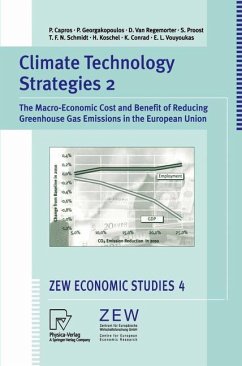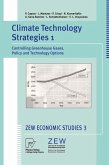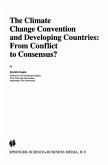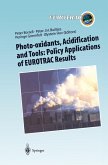Pantelis Capros, Panagiotis Georgakopoulos, Denise Van Regemorter, E. Lakis Vouyoukas, Tobias F. N. Schmidt, Henrike Koschel, Klaus Conrad, Stef ProostThe Macro-Economic Cost and Benefit of Reducing Greenhouse Gas Emissions in the European Union
Climate Technology Strategies 2
The Macro-Economic Cost and Benefit of Reducing Greenhouse Gas Emissions in the European Union
Mitarbeit:Capros, Pantelis; Mantzos, Leonidas; Criqui, Patrick
Pantelis Capros, Panagiotis Georgakopoulos, Denise Van Regemorter, E. Lakis Vouyoukas, Tobias F. N. Schmidt, Henrike Koschel, Klaus Conrad, Stef ProostThe Macro-Economic Cost and Benefit of Reducing Greenhouse Gas Emissions in the European Union
Climate Technology Strategies 2
The Macro-Economic Cost and Benefit of Reducing Greenhouse Gas Emissions in the European Union
Mitarbeit:Capros, Pantelis; Mantzos, Leonidas; Criqui, Patrick
- Broschiertes Buch
- Merkliste
- Auf die Merkliste
- Bewerten Bewerten
- Teilen
- Produkt teilen
- Produkterinnerung
- Produkterinnerung
Climate technology becomes more and more relevant in international environmental policy negotiations. At the Kyoto conference binding emission reduction targets have been established for several regions of the world. The major challenge is how to realize these reduction goals with minimum costs without generating new distributional and social difficulties. The book analyses the macroeconomic structural and distributional impacts of greenhouse gas mitigation strategies for the EU and the member states.
Andere Kunden interessierten sich auch für
![Climate Technology Strategies 1 Climate Technology Strategies 1]() Pantelis CaprosClimate Technology Strategies 183,99 €
Pantelis CaprosClimate Technology Strategies 183,99 €![Flexible Mechanisms for an Efficient Climate Policy Flexible Mechanisms for an Efficient Climate Policy]() Flexible Mechanisms for an Efficient Climate Policy42,99 €
Flexible Mechanisms for an Efficient Climate Policy42,99 €![Man-Made Climate Change Man-Made Climate Change]() Man-Made Climate Change53,49 €
Man-Made Climate Change53,49 €![The Climate Change Convention and Developing Countries The Climate Change Convention and Developing Countries]() J. GuptaThe Climate Change Convention and Developing Countries83,99 €
J. GuptaThe Climate Change Convention and Developing Countries83,99 €![Photo-oxidants, Acidification and Tools: Policy Applications of EUROTRAC Results Photo-oxidants, Acidification and Tools: Policy Applications of EUROTRAC Results]() BorrellPhoto-oxidants, Acidification and Tools: Policy Applications of EUROTRAC Results83,99 €
BorrellPhoto-oxidants, Acidification and Tools: Policy Applications of EUROTRAC Results83,99 €![Economics of Climate Change: The Contribution of Forestry Projects Economics of Climate Change: The Contribution of Forestry Projects]() Wolfram KägiEconomics of Climate Change: The Contribution of Forestry Projects83,99 €
Wolfram KägiEconomics of Climate Change: The Contribution of Forestry Projects83,99 €![The State of Environment in Asia The State of Environment in Asia]() Shun'ichi Teranishi (ed.)The State of Environment in Asia63,99 €
Shun'ichi Teranishi (ed.)The State of Environment in Asia63,99 €-
-
-
Climate technology becomes more and more relevant in international environmental policy negotiations. At the Kyoto conference binding emission reduction targets have been established for several regions of the world. The major challenge is how to realize these reduction goals with minimum costs without generating new distributional and social difficulties. The book analyses the macroeconomic structural and distributional impacts of greenhouse gas mitigation strategies for the EU and the member states.
Hinweis: Dieser Artikel kann nur an eine deutsche Lieferadresse ausgeliefert werden.
Hinweis: Dieser Artikel kann nur an eine deutsche Lieferadresse ausgeliefert werden.
Produktdetails
- Produktdetails
- ZEW Economic Studies 4
- Verlag: Physica / Physica-Verlag / Physica-Verlag HD
- Artikelnr. des Verlages: 978-3-7908-1230-5
- 1999.
- Seitenzahl: 240
- Erscheinungstermin: 14. Oktober 1999
- Englisch
- Abmessung: 235mm x 155mm x 14mm
- Gewicht: 324g
- ISBN-13: 9783790812305
- ISBN-10: 3790812307
- Artikelnr.: 08383956
- Herstellerkennzeichnung Die Herstellerinformationen sind derzeit nicht verfügbar.
- ZEW Economic Studies 4
- Verlag: Physica / Physica-Verlag / Physica-Verlag HD
- Artikelnr. des Verlages: 978-3-7908-1230-5
- 1999.
- Seitenzahl: 240
- Erscheinungstermin: 14. Oktober 1999
- Englisch
- Abmessung: 235mm x 155mm x 14mm
- Gewicht: 324g
- ISBN-13: 9783790812305
- ISBN-10: 3790812307
- Artikelnr.: 08383956
- Herstellerkennzeichnung Die Herstellerinformationen sind derzeit nicht verfügbar.
1 Introduction.- 1.1 The Economic Cost of CO2 Abatement.- 1.2 Structure of the Volume.- 2 Literature Review.- 2.1 Introduction.- 2.2 Models and Studies for the Cost of Ghg Abatement.- 2.3 Gaps From Previous Studies and Directions of Future Research.- 3 Definition Of Policy Instruments And Criteria For Their Assessment.- 3.1 Introduction.- 3.2 Criteria for the Assessment of Environmental Policy Instruments.- 3.3 Selected Environmental Policy Instruments.- 3.4 Evaluation of Environmental Policy Instruments.- 3.5 Conclusions.- 4 Baseline Scenario for the Eu and Overview of Policy Simulations.- 4.1 Introduction.- 4.2 The Baseline Scenario: The European Economy To 2010.- 4.3 Environmental Constraints in The Gem-E3 Model: An Overview of the Model Mechanisms.- 4.4 Definition of the Policy Scenarios.- 5 The Cost of Meeting Emission Reduction Targets: Pollution Permits.- 6 The Role of Accompanying Policies.- 6.1 Recycling Through the Reduction of Labour Costs.- 6.2 Recycling Through the Reduction Of Investment Costs.- 6.3 No Recycling.- 7 The Role of Energy Saving Investment.- 7.1 Model Specification.- 7.2 Simulation Results.- 8 Internalisation of Externalities.- 8.1 Introduction.- 8.2 Methodology.- 8.3 The Externalities and Their Damage Valuation.- 8.4 The Internalisation Scenario.- 8.5 Simulation Results.- 9 Burden Sharing.- 9.1 Introduction.- 9.2 Equity and Efficiency.- 9.3 Operationalisation of Equity Rules.- 9.4 The Burden Sharing Issue in the Eu Context.- 9.5 Simulation of an Eu Wide Permit Scheme Under Alternative Equity Rules.- 9.6 Conclusion.- 10 Sensitivity Analysis.- 10.1 Labour Market Rigidities and the Double Dividend Issue.- 10.2 World Context.- 11 Conclusions.- 11.1 Emission Abatement and Sustainable Development.- 11.2 Policy Instruments.- 11.3 Policy Evaluation Criteria and Main Results.- 12 Appendix: Brief Description of Models Used in the Study.- 12.1 GEM-E3.- List of Figures.- List of Tables.- References.
1 Introduction.- 1.1 The Economic Cost of CO2 Abatement.- 1.2 Structure of the Volume.- 2 Literature Review.- 2.1 Introduction.- 2.2 Models and Studies for the Cost of Ghg Abatement.- 2.3 Gaps From Previous Studies and Directions of Future Research.- 3 Definition Of Policy Instruments And Criteria For Their Assessment.- 3.1 Introduction.- 3.2 Criteria for the Assessment of Environmental Policy Instruments.- 3.3 Selected Environmental Policy Instruments.- 3.4 Evaluation of Environmental Policy Instruments.- 3.5 Conclusions.- 4 Baseline Scenario for the Eu and Overview of Policy Simulations.- 4.1 Introduction.- 4.2 The Baseline Scenario: The European Economy To 2010.- 4.3 Environmental Constraints in The Gem-E3 Model: An Overview of the Model Mechanisms.- 4.4 Definition of the Policy Scenarios.- 5 The Cost of Meeting Emission Reduction Targets: Pollution Permits.- 6 The Role of Accompanying Policies.- 6.1 Recycling Through the Reduction of Labour Costs.- 6.2 Recycling Through the Reduction Of Investment Costs.- 6.3 No Recycling.- 7 The Role of Energy Saving Investment.- 7.1 Model Specification.- 7.2 Simulation Results.- 8 Internalisation of Externalities.- 8.1 Introduction.- 8.2 Methodology.- 8.3 The Externalities and Their Damage Valuation.- 8.4 The Internalisation Scenario.- 8.5 Simulation Results.- 9 Burden Sharing.- 9.1 Introduction.- 9.2 Equity and Efficiency.- 9.3 Operationalisation of Equity Rules.- 9.4 The Burden Sharing Issue in the Eu Context.- 9.5 Simulation of an Eu Wide Permit Scheme Under Alternative Equity Rules.- 9.6 Conclusion.- 10 Sensitivity Analysis.- 10.1 Labour Market Rigidities and the Double Dividend Issue.- 10.2 World Context.- 11 Conclusions.- 11.1 Emission Abatement and Sustainable Development.- 11.2 Policy Instruments.- 11.3 Policy Evaluation Criteria and Main Results.- 12 Appendix: Brief Description of Models Used in the Study.- 12.1 GEM-E3.- List of Figures.- List of Tables.- References.








